
Little Big Bangs
Gamma-ray bursts (GRBs) are some of the most intense and energetic phenomena in the universe.
Said to be the birth-cries of black holes, they’re just about the biggest bangs our universe has seen since that biggest Big Bang of them all. But GRBs are brief, extremely violent, and totally destructive; they’re supernovae raised to the umpteenth degree.
And they have a nasty penchant for emitting twin beams of astonishingly deadly gamma radiation. So deadly that, if our own planet were to be swept by such a death ray, we could expect our ozone layer to be boiled off in an instant, followed by a withering storm of unobstructed solar UV radiation, and mass extinctions of a catastrophic magnitude.
Palaeontologists and astronomers have even implicated a GRB in one of the greatest mass die-offs in Earth’s history—the Ordovician-Silurian Mass Extinction, over 443 million years ago, in which nearly 85% of all living things perished. So it’s a safe bet to assume that any kind of life as we know it is highly unlikely to evolve in a galaxy or region of space where these cosmic buzzkills are raining on everybody’s parade.
But the fact that we humans are here to contemplate these things shows that—Ordovician extinctions notwithstanding—by and large, our planet has managed to get through the GRB roulette relatively scot-free.
So far, so obvious; but here’s where it gets interesting. A team of researchers has used this spare fact to reach some pretty significant conclusions about the nature of our universe, and they’ve even used it to place a lower bound on the value of the so-called cosmological constant—that still very mysterious force that controls the acceleration and ultimate destiny of the cosmos.

Gamma-Ray Bursts and the Multiverse
Essentially, the researchers used an “anthropic cosmological” argument—the notion that our very existence ensures that the universe has a set of fundamental laws conducive to the evolution of intelligent life. They maintain that, on the basis of this argument, the value of the cosmological constant can be narrowly constrained.
In other words, the acceleration of the universe could not have been too high, else matter would have flown apart before planets and stars and galaxies could form; on the other hand, it couldn’t be too low, or galaxies—particularly small, low-metallicity starburst galaxies, where GRBs love to reside—would be too close together, sterilizing each other and miscarrying the potential intelligences they might otherwise have fostered.
“This is important, as it gives clues to the question of what is the origin of this constant,” says Tsvi Piran of The Hebrew University in Jerusalem, a coauthor of the study. “It is generally believed that the value of the cosmological constant is determined by some quantum process, and understanding its relevant range is important to have a clue on its origin.”
So what does that mean in terms of the numbers?
Right now, scientists estimate the cosmological constant to be 10-123; and they know it can’t be any greater than 10-120, or stars and planets would never have condensed in the first place. Using the anthropic argument about GRBs, they estimate that the lower bound must be 10-124, or else there wouldn’t be enough protected, GRB-free cocoons in the universe to permit the evolution of intelligent observers.

Whatever’s behind the cosmological constant, it seems to have just the right value to permit planets and life to form, and yet keep everything far enough apart that life isn’t blasted out of existence before it has the chance to thrive. And the new research even places some temporal limits on the evolution of life in our universe: prior to 7 billion years ago, very few protective “halos” existed, an age limit that coincides fairly well with the formation of the earth 4.5 billion years ago.
So if it’s granted that the ascent to self-awareness is a laborious, multi-billion-year journey, then it follows that intelligent life must be a pretty recent phenomenon in cosmic history. And it further means that, if we’re fortunately situated in space, then we’re also fortunately placed in time and even in the multiverse—that hypothetical continuum of parallel universes—which may include universes with every conceivable value of the cosmological constant.
Kind of makes you appreciate our wonderful universe just a little bit more, doesn’t it?